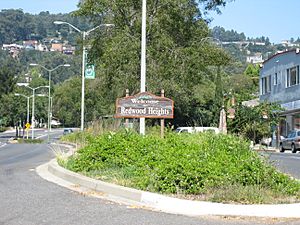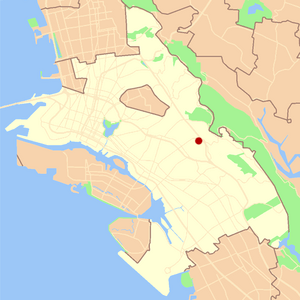Redwood Heights, Oakland, California facts for kids
Quick facts for kids
Redwood Heights
|
|
|---|---|

A sign welcoming motorists to Redwood Heights
|
|

Location of Redwood Heights in Oakland
|
|
| Country | United States |
| State | California |
| County | Alameda |
| City | Oakland |
Redwood Heights is a lively residential neighborhood located in the hills of East Oakland, California. It's known for being a diverse area with many different cultures living together. The neighborhood is centered around Redwood Road, which was once used for moving giant redwood trees.
The heart of the community is the Redwood Heights Elementary School and its recreation center. This center also provides after-school care for students. Another cool spot is Avenue Terrace Park, also called Jordan Park, where you can hang out and play.
Most of the homes in Redwood Heights were built between the 1920s and 1950s. You can see many different styles, like craftsman, "storybook," and ranch designs. The neighborhood is a great example of Oakland's diversity, with people from many backgrounds living side-by-side.
Contents
A Look Back: Redwood Heights History
Redwood Heights has a fascinating past, from ancient forests to a modern, diverse community. Let's explore how this area changed over time.
Early Days: Native People and Spanish Influence
Before the 1820s, the land was home to the Jalquin-Irgen people, a group of California Native Americans. They saw themselves as deeply connected to nature and didn't believe in owning land. A bench in Leona Canyon remembers them today.
The first non-native people to arrive were the Spanish-Californios. Their huge land grant, called Peralta, included this area. Peralta Creek, which flows through the neighborhood, is named after them.
The Redwood Logging Era (1840s-1860s)
In 1848, California became part of the United States after the Mexican-American War. Soon after, many people came to the area to cut down the massive redwood trees. These trees were so tall they could be seen from ships in the San Francisco Bay!
How Redwoods Were Logged
Logging was hard work. Two men would spend a whole day cutting down one giant tree by hand. Some trees were over 1,000 years old and measured more than 33 feet across! After felling, the trees were stripped of branches and split into boards using dynamite. Teams of oxen then dragged the lumber down narrow roads, including what is now Redwood Road. By 1860, most of the old-growth forest was gone.
Joaquin Miller and the New Forests (1880s)
In the 1880s, there was a brief "gold rush" scare in Oakland, but it turned out to be fake gold. More importantly, a writer named Joaquin Miller had a big vision. He planted 70,000 trees on the cleared hills, many of them eucalyptus.
Miller also made sure that his large land holdings would become public parks after he died. This preserved a huge open space that is now Joaquin Miller Park. The park has walking trails and is home to one of the oldest second-growth redwood forests in the West.
Growing Pains and New Homes (1900s-1930s)
After the big 1906 San Francisco earthquake and fire, many people moved across the bay to Oakland, including to areas like Redwood Heights.
Developing the Neighborhood
In the 1920s, the area we know as Redwood Heights started as a new housing development called Avenue Terrace. It was advertised as a great place for Oakland's growing middle class. Homes and land sold for about $5,000. There were also local shops like grocery stores and a hair salon.
More homes were built in the 1930s, creating new sections like Sunset Manor and Redwood Gardens. An interesting stone marker, or "obelisk," at 35th Avenue and Victor, likely marked the original Avenue Terrace development. Some residents even paid themselves to get streets and sidewalks installed.
Community and Change (1940s-1960s)
In 1944, some neighbors formed the Redwood Heights Improvement Association. After World War II, new highways like Highway 13 and Highway 580 were built, changing how people traveled. The old streetcar lines were removed in the 1950s, making cars the main way to get around.
Opening Doors to Diversity
The powerful Civil Rights Movement of the 1960s helped the neighborhood become more open to people from all cultures. In the early 1960s, the Lincoln Square Shopping Center was completed. A redwood tree was planted at the elementary school in 1963 to remember President John F. Kennedy.
Modern Redwood Heights (1970s-Today)
In the 1970s, the Redwood Heights Improvement Association helped widen Redwood Road to handle more traffic. Even though the association started in a time when neighborhoods were often separated by race, it eventually welcomed many new immigrant families. These families have helped make Redwood Heights the wonderfully diverse place it is today.
A Stronger Community
After the 1989 earthquake, the elementary school was rebuilt to be very safe. In the 1980s, the Improvement Association changed its name to the Redwood Heights Neighborhood Association. Its new goal was to support the school and encourage neighbors to socialize, making the community a pleasant and safe place to live.
In 2015, the association changed its name again to the Redwood Heights Association. It now works as a nonprofit for all of Oakland, focusing on "Bringing People Together." They host community events and work on projects to improve life for everyone in Oakland. You can find more historical articles about the area on their website.

